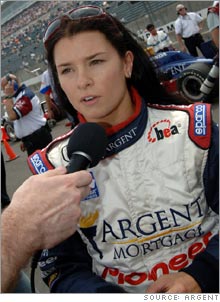 |
| The media attention around Danica Patrick is just what the troubled race needed. |
|
 |
|
|
|
|
|
|
NEW YORK (CNN/Money) -
Danica Patrick on Sunday restored to the Indianapolis 500 something it once took for granted: the status and attention that comes with being a major sporting event.
Patrick was not the first woman to run at Indy, but the first to be truly competitive with her male counterparts. She finished fourth, but made history by being the first woman driver to lead the race. She held the lead for 19 of the event's 200 laps, and was out front with seven laps to go.
More important, Patrick brought the race badly needed attention.
Her picture covered the top of USA Today on Friday, and her name is one of the top searches on Google. A story about the race was on the front page of the New York Times Monday for the first time since 1981.
Indy was also in the lead position on most sports pages, attention the race didn't get in much of the country's papers in recent years.
The media flooded to Indianapolis -- and not just the normal racing or sports press. Glamour magazine, along with People and Us have been there to write about her. So has "Good Morning American" and two of the network evening news program.
"The sporting public is certainly well aware of her and it will grab a lot of attention," said Bob Toms, senior producer at ABC Sports, when talking to reporters last week before the race. "It has captured an amazing amount of attention over the course of the last couple weeks, more than any of us would have anticipated."
With her success and attention Sunday, Patrick can probably count on more success in the future. One reason is money.
Drivers needs both talent and resources behind them, as the top teams dominate the top 10 finishers year after year.
Patrick has a much better financed team behind her -- and a much better car -- than previous women drivers have had at Indy. She drove for Rahal Letterman Racing, the group that won the race last year.
Only 4.1 percent of U.S. households tuned into last year's rain-soaked race. That's fewer people than watched the lowest-rated network broadcast of a Nascar race last year. The race has become the second-most watched race on the Sunday of Memorial Day weekend in recent years, trailing the Nascar race that night.
The early reading on its TV ratings this year showed that 6.6 percent of homes in major television markets tuned into the race, up 40 percent from a year ago.
While the ratings for the Nascar race Sunday night weren't immediately available Monday, it's likely Indy finally won that race with Nascar this year.
Women won't drive rating surge
Don't think that Patrick's media win was due to a huge growth in female race fans or viewers. The fact is, women still make up a relatively small percentage of sports viewership (even in this Title IX age, when more women are interested than ever before).
Two years ago when women golfing star Annika Sorenstam became the first women to play in a PGA event, women made up only 35 percent of the audience on those broadcasts on USA Network, or exactly the same percentage of women who watch typical PGA tournaments on the broadcast networks.
Women's sports like the LPGA, women's tennis and the Women's National Basketball Association also draw a predominantly male viewership, said Neal Pilson, a television sports consultant who has worked with women's leagues in the past.
"When women's sports appear on television, they appear on channels watched by men or at times during the day when the television set is normally controlled by men, such as weekend afternoons," he said.
So even though Patrick made the Indy 500 a ratings winner, it likely was because she drew male sports fans back to the broadcasts.
The Tiger of racing?
Pilson said that if Patrick had won the Indy 500, it would be one of the top sports stories of the year.
David Stark, senior vice president of marketing at Argent Mortgage, her primary sponsor, said a win would have made her an instant global celebrity. Both are probably right. But she's positioned to capture further attention and endorsements, just by doing well on Sunday.
Stark said the mortgage lender's own research has shown that even before the race she already was as popular as any of its other athletes, including Michael Phelps, the Olympic swimmer who won eight medals last summer in Athens.
"She has great appeal across every segment, women, men, Generation X, Y," said Stark. "Men respect her. Women respect her."
Patrick can continue to be a superstar in the sport, even without taking the checkered flag Sunday. "I think her appeal is set in stone," Stark said.
But to continue at this level of media attention and frenzy, she'll have to be one of the sport's top drivers.
Without some continued level of success, she'll likely fall back into the relative anonymity of the three women who have raced at Indy before her, as well as the relatively low level of general public recognition achieved by the other 32 male drivers in the race.
For more on the business of sports, click here.

|